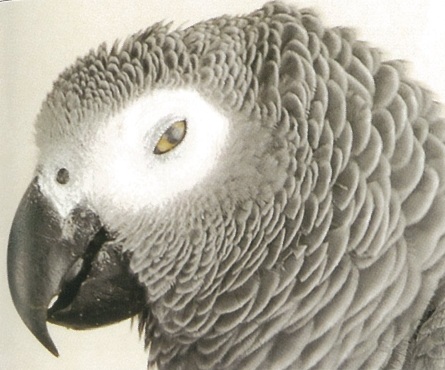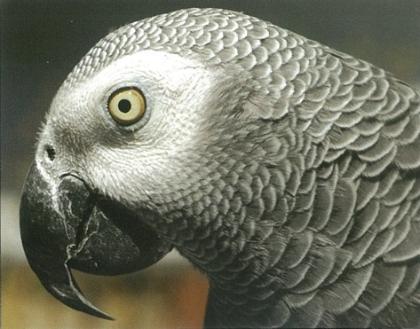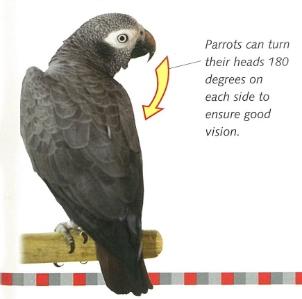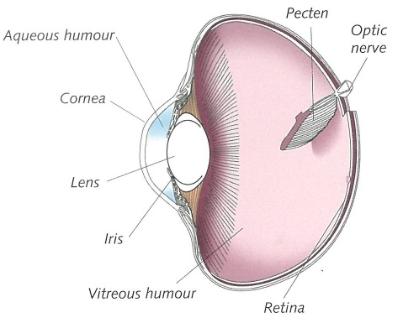As with other parrots, a grey's keenest sense is its sight and these birds have a number of adaptations to their eyes which greatly improve their vision compared to human sight. The part of the eye you can see is only a small part of the eyeball itself, which is much larger. Examination of the skull of a bird and its eyesockets reveals the true size of the eyeballs. Parrot's eyes are arranged to give them almost 360 degree 'all-round' vision, both vertically and horizontally. This ensures they can easily spot danger which may come from any direction. They also have good binocular (stereo) vision, as we do, for objects which are near and in front of them. All parrots can switch back and forth between their all-round monocular vision to close-up stereo vision in a split second.
you can see as a pale membrane when the bird blinks. While human colour vision is limited to mixes of red, green and blue light, parrots see ultra-violet light as another one or two distinct colours as well. This is thought to help them distinguish between the sexes, as some colour differences between males and females may only occur in UV colours. Such vision may also help them to identify the fruits they commonly eat from some distance and determine which of these are ripe. Unlike humans, parrots have voluntary control of their iris, and can open and
close their pupils rapidly at will. This ability to 'flash' their eyes is used to express excitement or to threaten another bird.
Birds process visual information at a much higher rate than we do. Our brain takes in about 16 images per second from our eyes. Films and videos are projected at around 25 frames per second, so this gives humans the illusion of a moving image. However, birds can take in 70 to 170 images per second. They probably need to be able to do this in order to see well when flying at high speed through the trees.
Better colour vision than humans
Parrots' eyes are somewhat flattened, not spherical like ours, so they have limited eye movement within the socket. Instead, they tend to move the whole head when looking at objects. Parrots also have a third eyelid whichyou can see as a pale membrane when the bird blinks. While human colour vision is limited to mixes of red, green and blue light, parrots see ultra-violet light as another one or two distinct colours as well. This is thought to help them distinguish between the sexes, as some colour differences between males and females may only occur in UV colours. Such vision may also help them to identify the fruits they commonly eat from some distance and determine which of these are ripe. Unlike humans, parrots have voluntary control of their iris, and can open and
close their pupils rapidly at will. This ability to 'flash' their eyes is used to express excitement or to threaten another bird.
Birds process visual information at a much higher rate than we do. Our brain takes in about 16 images per second from our eyes. Films and videos are projected at around 25 frames per second, so this gives humans the illusion of a moving image. However, birds can take in 70 to 170 images per second. They probably need to be able to do this in order to see well when flying at high speed through the trees.

As this bird blinks, its third eyelid which extends as a pale membrane over the surface of the eye becomes visible.

A nercous or frightened bird shows a wide staring eye which is fully opened.

The position of a grey's eyes give it almost complete all-round vision vertically and horizontally.

On seeing any signs of danger, the bird will sound an
alarm note appropriate to the nature of the threat.
alarm note appropriate to the nature of the threat.

Cross-section through a parrot's eye. The vascular pecten, unique to birds, is thought to assist with blood circulation within the eye.